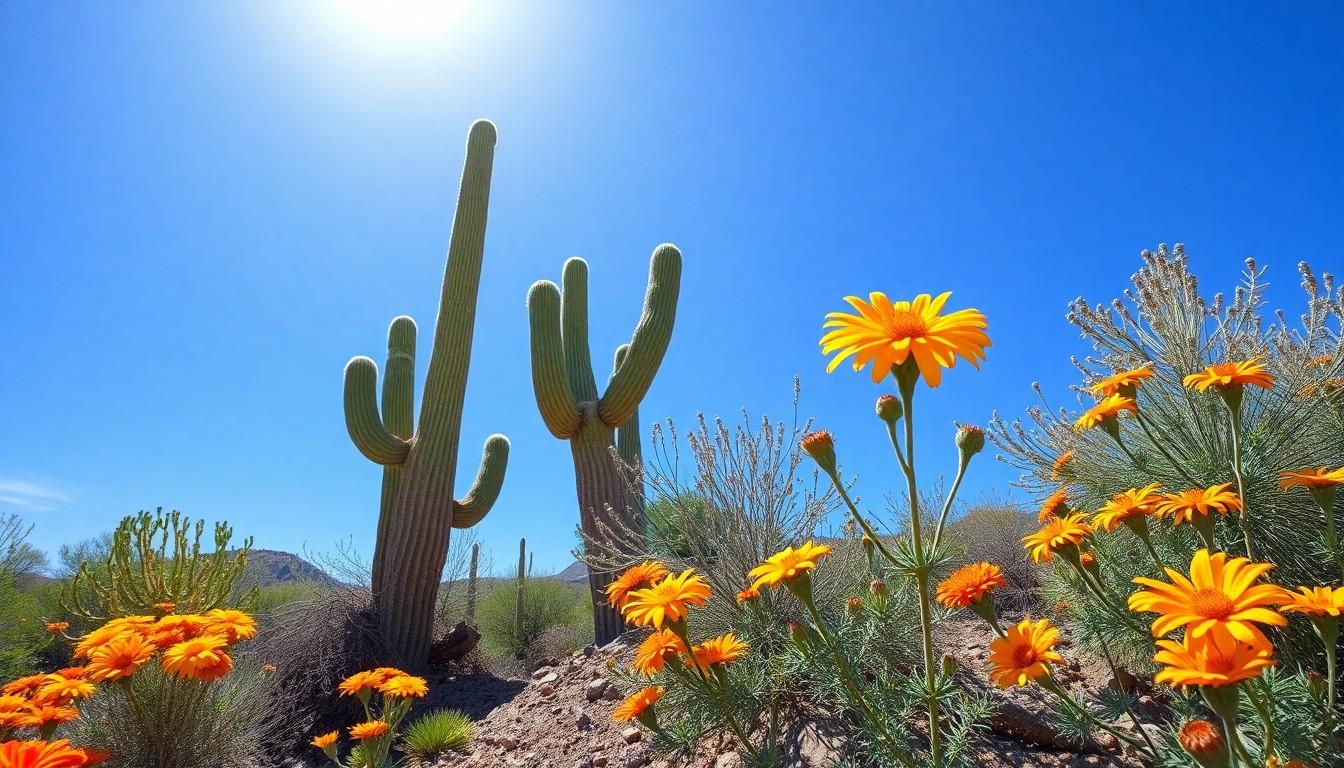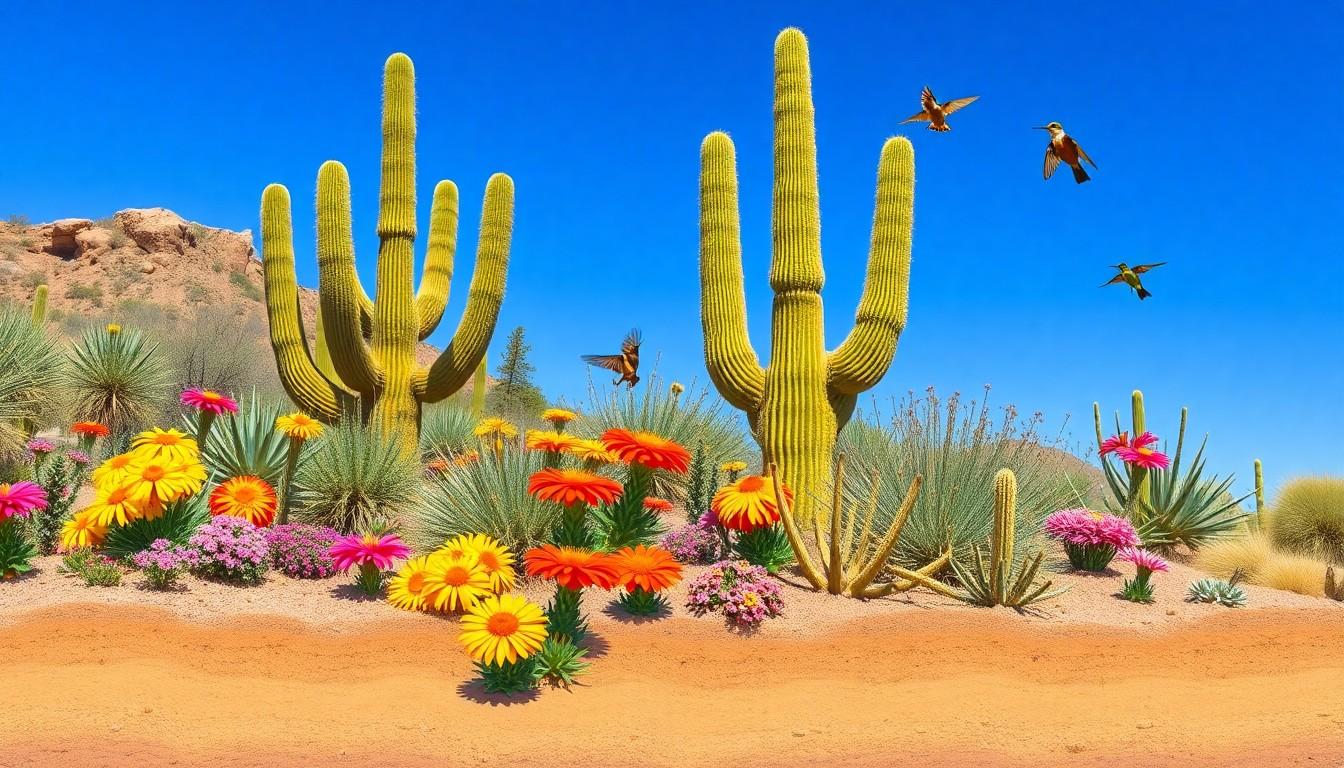Arizona’s landscape is a vibrant tapestry of native plants that thrive in its unique climate. From the iconic saguaro cactus to the colorful desert marigold, these resilient flora not only beautify the arid terrain but also support local wildlife. Choosing native plants isn’t just a gardening trend; it’s a smart way to conserve water, reduce maintenance, and create a sustainable environment.
Imagine transforming your yard into a desert oasis where hummingbirds and butterflies flock, all while making your neighbors green with envy. Plus, native plants are like the superheroes of the gardening world—no capes required! They’re adapted to thrive in Arizona’s sun-soaked climate, making them the perfect low-maintenance addition to any garden. Let’s dive into the world of Arizona’s native plants and discover how they can turn any outdoor space into a flourishing paradise.
Overview of Native Plants to Arizona
Native plants in Arizona thrive due to their adaptation to the local environment. These species can survive extreme temperatures and arid conditions, making them ideal for landscaping. For instance, the saguaro cactus, an iconic symbol of the Southwest, stores water to endure prolonged drought periods.
Desert marigold exhibits bright yellow blooms, attracting pollinators like butterflies and bees. It grows well in nutrient-poor soil and contributes to the vibrant desert ecosystem. Another notable plant, the creosote bush, emits a distinctive odor when wet, which helps to mark its territory and attracts wildlife.
Planting native species also enhances biodiversity. Many plants provide habitats and food sources for indigenous birds, insects, and other animals. For example, the mesquite tree offers shade while its pods serve as food for local wildlife.
Conservation of water is a significant benefit of native plants. Their deep root systems tap into underground moisture, reducing the need for supplemental irrigation. This characteristic helps maintain sustainable landscapes and promotes environmental responsibility.
Incorporating these plants into gardens offers a practical solution for homeowners. Select from varieties like Apache plume, which features fluffy white plumes and requires minimal care. Yard transformations can feature these vibrant species, creating inviting spaces that support local ecosystems and conserve resources.
Benefits of Native Plants

Native plants in Arizona offer numerous advantages that enhance both gardens and the surrounding environment. Their resilience to local conditions sets them apart.
Environmental Benefits
Native plants contribute to biodiversity by supporting various wildlife species. Many of these plants, such as the saguaro cactus and desert marigold, provide crucial habitats and food sources for pollinators. Their deep root systems stabilize the soil and prevent erosion, improving local water retention capabilities. These plants require less water than non-native varieties, thereby promoting water conservation. Additionally, they sequester carbon, helping mitigate the effects of climate change. By integrating native species, gardens become active participants in sustaining Arizona’s unique ecosystems.
Economic Benefits
Incorporating native plants results in cost savings for homeowners. Reduced irrigation needs decrease water bills significantly. Native species often require less maintenance, meaning fewer expenditures on fertilizers, pesticides, and labor. Choosing native plants can enhance property values, as landscapes that reflect the region’s natural beauty attract potential buyers. These plants also contribute to the longevity of landscaping because they are adapted to withstand Arizona’s climate challenges. Long-term investments in native plants yield financial advantages while supporting sustainable practices.
Popular Native Plants in Arizona
Arizona hosts a diverse array of native plants ideal for gardens and landscapes. These plants withstand extreme conditions and enrich local ecosystems.
Cacti
Cacti thrive in Arizona’s arid climate. The iconic saguaro cactus stands tall, offering both beauty and habitat for birds. Barrel cactus provides colorful blooms and food sources for various wildlife. Prickly pear cactus, known for its vibrant pads and fruit, attracts pollinators while providing a source of water in dry conditions. These cacti are drought-resistant and require minimal care, making them perfect for sustainable gardening in Arizona.
Wildflowers
Wildflowers add bursts of color and support biodiversity. Desert marigold brightens landscapes with its yellow blooms, attracting bees and butterflies. The bluebell flower provides essential nectar to pollinators while thriving in limited rainfall. Evening primrose opens its beautiful flowers at dusk, delighting both gardeners and wildlife. These wildflowers adapt well to Arizona’s growing seasons and enhance the garden’s visual appeal.
Shrubs
Shrubs play a crucial role in Arizona’s native plant community. Creosote bush flourishes in dry environments, providing food and shelter for various animals. Apache plume offers stunning feathery flowers and supports pollinator populations. The mesquite tree provides vital shade and sustenance for local birds while improving soil conditions. These shrubs contribute to water conservation efforts through their deep root systems, fostering resilient landscapes.
Growing Native Plants
Growing native plants in Arizona yields numerous benefits, including reduced water usage and enhanced biodiversity. To support these plants effectively, consider their specific requirements.
Soil Requirements
Soil quality significantly impacts the growth of native plants. Sandy or rocky soils provide excellent drainage, necessary for plants like the saguaro cactus and creosote bush. Nutrient-rich soils aren’t essential for most native species since they adapt to poorer conditions. Testing soil pH before planting ensures compatibility, with many native plants thriving in alkaline to neutral pH levels. Amending soil with organic materials improves structure and fertility, promoting healthy root systems.
Watering Needs
Watering practices differ for native plants compared to traditional options. Newly planted natives typically require regular watering for the first few months to establish roots. Once established, many species thrive on minimal water due to deep root systems that access moisture. Overwatering can lead to root rot, while drought stress encourages resilience. Xeriscaping techniques, incorporating native plants, contribute to landscape sustainability, minimizing the need for supplemental irrigation in Arizona’s arid climate.
Preserving Arizona’s Native Flora
Conserving Arizona’s native flora enhances ecological health. Establishing native gardens creates habitats for wildlife and supports local pollinators. Selecting plants like saguaro cacti, creosote bushes, and desert marigolds helps promote biodiversity in the region.
Understanding the unique adaptations of these plants is vital for preservation efforts. Many native species, such as mesquite trees, have deep root systems that access moisture below the surface, reducing reliance on irrigation. Sustainable landscaping practices that incorporate these plants minimize water consumption, which is crucial in arid environments.
Fostering awareness about the benefits of native plants encourages community involvement. Local organizations often host workshops and events focused on native gardening techniques, educating residents about the significance of these species. Engaging in native plant initiatives supports local ecosystems and strengthens community ties.
Monitoring local native flora populations helps identify species at risk. By participating in citizen science projects, residents can contribute to tracking and protecting these valuable plants. Efforts to restore native habitats involve reintroducing species and removing invasive plants that threaten ecological balance.
Promoting native plant sales and expos raises awareness about their importance. Local nurseries specializing in native species provide resources to homeowners looking to create sustainable landscapes. Educational materials and expert advice assist in selecting appropriate plants for specific garden conditions.
Collaborating with environmental organizations amplifies preservation efforts. Partnerships focused on habitat restoration projects yield positive outcomes for native plants and wildlife. Investing in native flora safeguards Arizona’s natural heritage and benefits future generations.
Conclusion
Embracing native plants in Arizona gardens offers a wealth of benefits that go beyond aesthetics. These resilient species not only thrive in the challenging climate but also play a crucial role in supporting local ecosystems. Homeowners can create beautiful landscapes that attract diverse wildlife while minimizing water usage and maintenance efforts.
By choosing native plants, individuals contribute to environmental sustainability and promote biodiversity. The positive impact on soil health and carbon sequestration further underscores the importance of these plants in combating climate change. With community support and awareness, preserving Arizona’s native flora becomes an achievable goal that benefits both people and the planet. Transforming yards into vibrant habitats is not just a gardening choice; it’s a commitment to a healthier ecosystem for generations to come.

